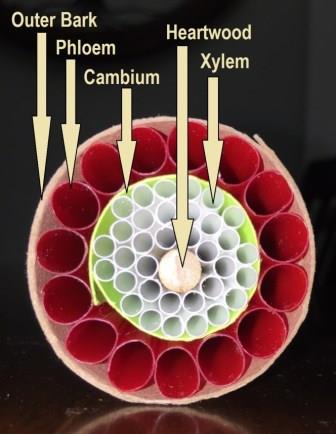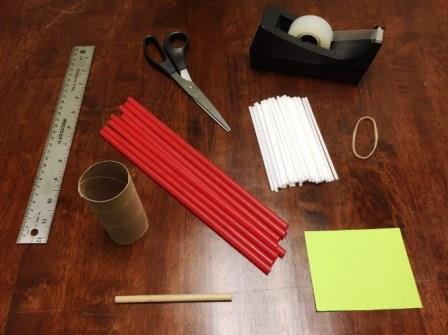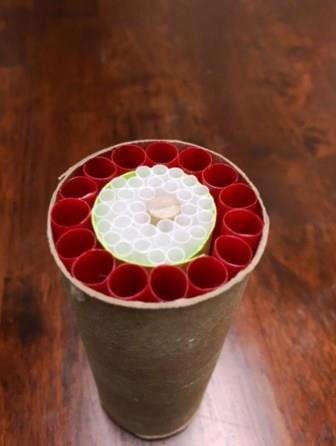When I would present to a group of students and talk about cambium, xylem, and phloem I would always say “picture me holding a handful of straws”. Well that gave me an idea to create this easy-to-make model of a cross-section of a tree trunk to help students visualize the inner layers of a tree.
 Materials List
Materials List
Here is a list of the materials you will need to make this model to represent a tree’s component parts:
- 1 toilet tissue tube (or half of a paper towel roll tube) (Outer Bark)
- ¼-inch wooden dowel rod cut to 4-inch length (Heartwood)
- 15 plastic drinking straws cut to 4-inch lengths (Phloem)
- 34 plastic coffee stirrers (or small straws) cut to 4-inch lengths (Xylem)
- 1 piece of colored card stock paper (Cambium)
- 1 rubber band
- Ruler
- Scissors
- Scotch tape
The cambium layer is extremely thin. An adaptation for your own model might be to use a thinner layer of paper or fabric (such as tissue paper or mesh tights) in between the layers of the two different sized straws (xylem and phloem).
Instructions
 Cut the ¼-inch dowel into a 4-inch piece (the length of the toilet tissue tube or paper towel roll tube)
Cut the ¼-inch dowel into a 4-inch piece (the length of the toilet tissue tube or paper towel roll tube)- Cut the card stock paper to measure 3 ¼ inches by 4 inches
- Cut the plastic drinking straws into 4-inch lengths
- Cut the plastic coffee stirrers into 4-inch lengths
- Grip the coffee stirrers in your hand and wrap the rubber band around them
- Insert the wooden dowel into center of the coffee stirrers
- Wrap card stock paper around the coffee stirrers and tape the edge tightly
- Slide the toilet tissue tube over the paper and stirrers
- Place one row of drinking straws between the card stock paper and the toilet tissue tube
- Make adjustments where needed to get the appropriate look
Parts of a Tree
 Use your model to explain how xylem and phloem transport water and food. More specifically, these are the functions of each tree part depicted in the model:
Use your model to explain how xylem and phloem transport water and food. More specifically, these are the functions of each tree part depicted in the model:
- Heartwood – forms the central core of the tree. It is made up of dense dead wood, and it provides strength.
- Xylem – brings water and nutrients up from the roots to the leaves. Older xylem cells become part of the heartwood.
- Cambium – a very thin layer of growing tree tissue. It makes cells that become new xylem, phloem, or cambium.
- Phloem – carries sap from the leaves to the rest of the tree. At certain times of the year, phloem may also move stored sugars from the roots up to the rest of the tree.
- Outer Bark – protects the tree from injury caused by insects, animals, plants, diseases, and fire.
PLT Activity Suggestions
Try coupling this model with the following Project Learning Tree lessons:
- #61 – The Closer You Look
- #62 – To Be a Tree
- #63 – Tree Factory
- #76 – Tree Cookies
For more teacher tips to help make sure students can identify the parts, structures, and functions of a tree or other plant, see Tree Factory Activity Cards.



3 comments on “An Easy-to-Make Model that Explains the Inner Parts of a Tree”
Awesome Rob! Thanks for sharing. Hope you make it back to our neck of the woods soon.
Love this activity! Rob is so creative!
I am teaching Botany to my children this semester. Our next lesson is about stems, so this is the perfect activity to go along with it and help them to have a better understanding of the function of the stem’s parts. It is a very creative and easy craft. I love it!